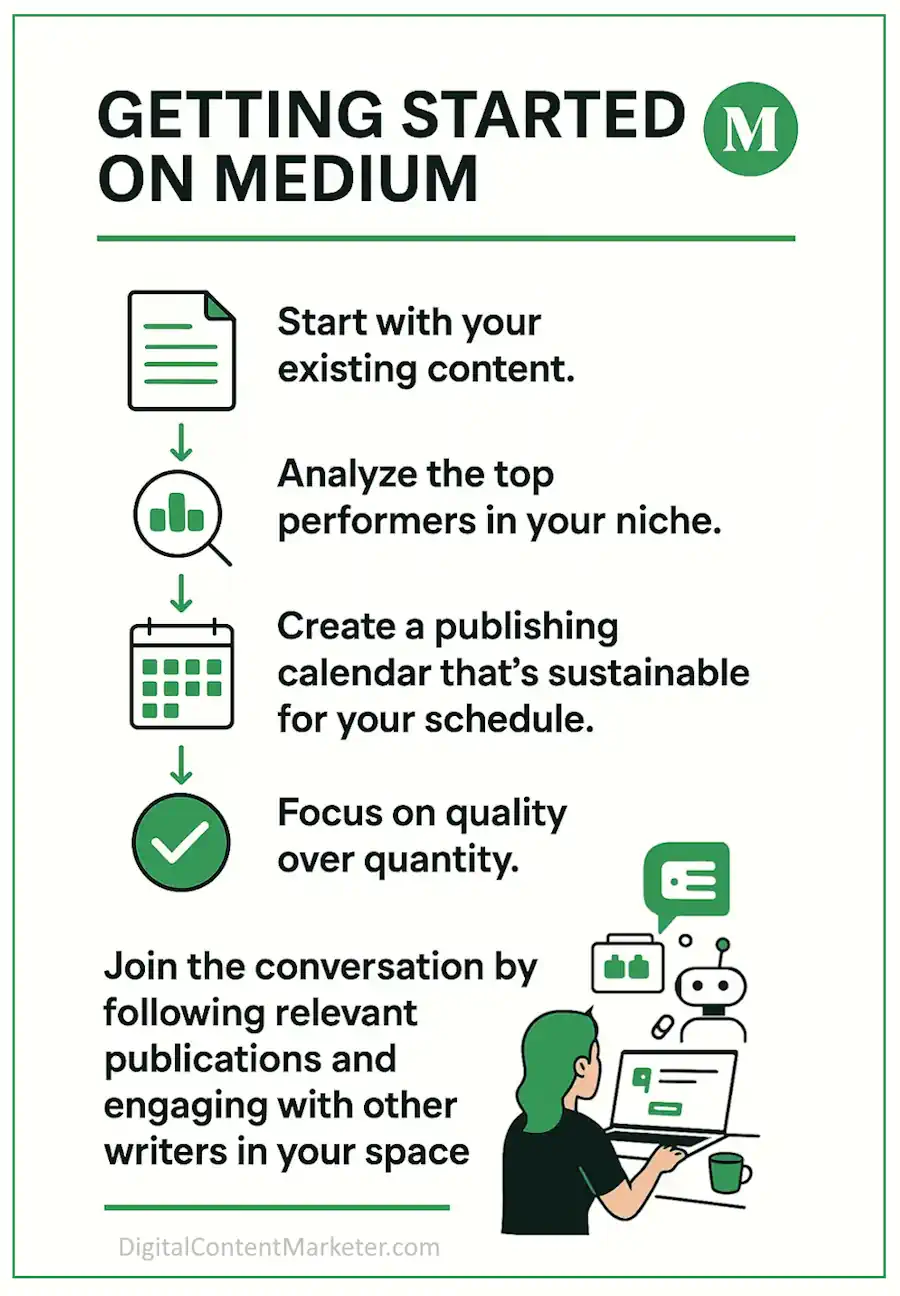You’ve built a marketing strategy around channels that demand constant feeding—social platforms that bury your posts within hours, ads that stop working the moment you stop paying, and an SEO approach that might take months to show results. The exhaustion of perpetually chasing visibility has you questioning whether content marketing is worth the effort at all.

Medium solves this fundamental problem by reversing the typical dynamics of audience building: instead of slowly accumulating followers through relentless promotion, you gain immediate access to readers already seeking exactly what you offer.
Whether you’re a seasoned marketer looking to expand your reach or a newcomer trying to establish authority in your niche, Medium’s unique ecosystem offers advantages that are difficult to replicate elsewhere. This platform isn’t just another content distribution channel—it’s a community built around ideas that matter, with readers who are willing to invest their time and attention in exchange for genuine value.
Instant Audience Access Without the Early Grind
Most platforms make you earn every click, build every follow, and fight tooth and nail just to be seen. Medium is different. It removes many of the barriers that usually stand between you and an audience.
Instead of asking you to bring your own traffic, it gives you access to a steady stream of engaged readers from day one. If you know how to write content that connects, Medium can help you skip the early grind and get your work in front of people who are already looking for it.
And if you’re already publishing elsewhere, it becomes a power boost for your reach without doubling your workload. When you write on your own blog, the odds are stacked against you at first.
You can publish amazing content and still end up with a dozen views, mostly bots or friends you begged to read it. On Medium, the audience is already there. These aren’t passive browsers either.
The Engaged Reader Advantage
Medium readers search by topic, follow writers they enjoy, and spend time actually reading. They’re not just skimming headlines or bouncing after a few seconds. They scroll, they highlight, they clap, and they comment.
That kind of attention is rare, and it gives your writing the chance to build real traction instead of dying on arrival. The platform’s built-in discovery engine is what makes that possible.
Medium doesn’t just wait for someone to stumble across your piece. As soon as you publish, the algorithm kicks in. It starts by testing your article with readers who follow similar topics.
If they stay and read it, Medium pushes it out further. If they clap or comment, that reach expands even more. And if your article gets curated by Medium’s staff or picked up by a publication, you’re suddenly in front of thousands—or tens of thousands—of people who would’ve never found your personal blog.
This system removes the need for constant self-promotion, which makes it easier to focus on the writing itself. Most content platforms are designed for short-term wins. Medium rewards consistency.
Authority Building Through Consistency
The more you publish, the more data it has about your style, your audience, and your topics. Over time, this builds a profile that helps Medium understand who to show your content to. It also builds trust with readers.

When someone clicks on one of your stories and finds it valuable, there’s a good chance they’ll check out your other articles too. That’s how authority starts to form. You’re not just some random person writing about email marketing or affiliate funnels.
You become someone they recognize, someone they follow, someone they quote. As your credibility grows, so does your influence. Readers start expecting quality from you, which nudges you to keep improving.
This doesn’t require expert-level credentials or years in the industry. What matters is that you show up with something useful, interesting, or insightful to say. If you do that often enough, people start treating you like an expert, even if you don’t call yourself one.
That kind of positioning doesn’t just live on Medium. You can link your articles in your newsletter, your social bios, or your LinkedIn profile. It becomes proof of expertise you can point to whenever you want to gain trust fast.
Natural Lead Generation Without the Hard Sell
Medium also opens the door to lead generation without sounding like you’re pitching. Unlike ad-driven platforms, Medium readers expect substance, not sales. But you can weave your offers into your stories in a way that feels natural.
Mention your free download at the end of a how-to article. Link to your service page when explaining a client result. Share your email list inside a personal story about business lessons.
These are soft entry points that pull readers into your world without putting up walls. The key is not to sell—just to show up as someone worth following. If you do that, they’ll find their way to your offers on their own.
Leveraging Network Effects for Rapid Growth
Most people try to grow their audience one subscriber at a time. On Medium, something as simple as getting featured in a publication can send you hundreds of new followers in a single day.
That’s where the network effects come into play. Medium isn’t just one big platform. It’s a web of smaller ecosystems—publications, topics, and communities. When your article does well in one part of that web, it starts to echo through the others.
A piece featured in a popular marketing publication can show up in topic feeds, recommendation carousels, and email roundups. It might even land on Medium’s homepage, which would give it a massive visibility boost.
These ripple effects are hard to manufacture anywhere else unless you’re paying for ads or spending years building connections. But Medium makes it possible with one well-written post.
When the algorithm sees that people are engaging with your work, it works harder to bring it to others. And when readers see your name pop up repeatedly under articles they enjoy, they start recognizing you.
Credibility Transfer Through Publications
That recognition is powerful. It means you don’t have to reintroduce yourself every time you publish. Your byline starts to carry weight. There’s also a credibility transfer that happens when you publish under big-name publications on Medium.
Being accepted into one of these groups acts like a stamp of approval. It says your content meets a certain standard, and readers treat it that way. It’s not just that more people see your article—it’s that they trust it faster.
That trust leads to more engagement. And that engagement leads to more visibility. It’s a cycle you can tap into again and again once you get the hang of it.
Evergreen Content That Works While You Sleep
Medium lowers the cost of attention. You don’t have to grind out short-form content every day just to stay relevant. A single strong article can work for you for months. It can keep showing up in search results, keep getting recommended, and keep attracting new readers without any extra effort from you.
That’s a better return on your time than what most platforms offer. And when you’re running a business, time is the most valuable currency you have. Publishing here doesn’t mean abandoning other platforms, either.

Medium can support and amplify what you’re already doing. If you’re growing a list, building a personal brand, or promoting a course, Medium becomes another entry point into your ecosystem.
Every article acts like a breadcrumb, leading curious readers toward your main hub. And because it’s written content, it tends to attract higher-quality leads—people who are more thoughtful, more engaged, and more likely to buy or share.
Beyond Traffic: Creating Valuable Business Leverage
The value of Medium isn’t just in the clicks. It’s in what those clicks can turn into when paired with the right strategy:
- An audience you didn’t have to build from scratch
- A platform that promotes your work for you
- A reputation that grows every time you show up with something worth reading
- A traffic source that keeps working while you’re off doing other things
All of that adds up to real leverage. And when you’re trying to grow a business without burning out, leverage matters.
Measuring Your Medium Success
To truly benefit from Medium as a marketer, you need to track more than just views and claps. Consider these key metrics:
- Conversion Rate: What percentage of your Medium readers are clicking through to your website or signing up for your email list?
- Article Longevity: Which pieces continue to generate traffic months after publication?
- Topic Performance: Which subjects resonate most with your target audience?
- Engagement Quality: Are readers leaving thoughtful comments that indicate deep engagement with your ideas?
- Attribution Value: How many customers mention finding you through Medium?
By measuring these metrics, you can refine your Medium strategy to maximize business impact rather than just vanity metrics.
Getting Started on Your Medium Marketing Journey
If you’re convinced that Medium deserves a place in your marketing strategy, here’s how to begin:
- Start with your existing content. What blog posts, newsletters, or presentations could be adapted for Medium’s audience?
- Analyze the top performers in your niche. What topics, formats, and approaches are working for them?
- Create a publishing calendar that’s sustainable for your schedule—consistency matters more than frequency.
- Focus on quality over quantity. One exceptional article per month will outperform four mediocre pieces.
- Join the conversation by following relevant publications and engaging with other writers in your space.

Medium isn’t just another marketing channel—it’s a place where your ideas can find the audience they deserve and where that audience can find their way back to your business. The platform rewards thoughtfulness, quality, and genuine expertise—exactly what real marketers should be offering anyway.
This is part 2 of our comprehensive Medium series. Next in our series: Pen Names vs. Real Names: Building Your Medium Brand Strategy – Learn how to establish the right identity for your Medium presence. Or return to the intro and the full series’ Table of Contents
